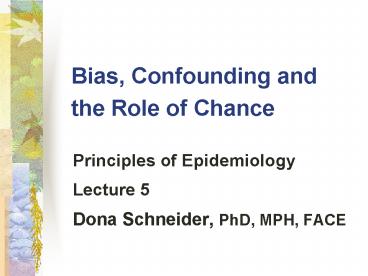Bias, Confounding and the Role of Chance - PowerPoint PPT Presentation
1 / 19
Title:
Bias, Confounding and the Role of Chance
Description:
OR = ad/bc = 2.8; RR = a/(a b)/c/(c d) = 1.6 ... Set up strict guidelines for data collection ... Randomly allocate observers/interviewer data collection assignments ... – PowerPoint PPT presentation
Number of Views:104
Avg rating:3.0/5.0
Title: Bias, Confounding and the Role of Chance
1
Bias, Confounding and the Role of Chance
- Principles of Epidemiology
- Lecture 5
- Dona Schneider, PhD, MPH, FACE
2
To Show Cause We Use
- Kochs Postulates for Infectious Disease
- Hills Postulates for Chronic Disease and Complex
Questions - Strength of Association Tonights entire
lecture - Biologic Credibility
- Specificity
- Consistency with Other Associations
- Time Sequence
- Dose-Response Relationship
- Analogy
- Experiment
- Coherence
3
To Show a Valid Statistical Association
- We need to assess
- Bias whether systematic error has been built
into the study design - Confounding whether an extraneous factor is
related to both the disease and the exposure - Role of chance how likely is it that what we
found is a true finding
4
BIAS
- Systematic error built into the study design
- Selection Bias
- Information Bias
5
Types of Selection Bias
- Berksonian bias There may be a spurious
association between diseases or between a
characteristic and a disease because of the
different probabilities of admission to a
hospital for those with the disease, without the
disease and with the characteristic of interest - Berkson J. Limitations of the application of
fourfold table analysis to hospital data.
Biometrics 1946247-53
6
Types of Selection Bias (cont.)
- Response Bias those who agree to be in a study
may be in some way different from those who
refuse to participate - Volunteers may be different from those who are
enlisted
7
Types of Information Bias
- Interviewer Bias an interviewers knowledge may
influence the structure of questions and the
manner of presentation, which may influence
responses - Recall Bias those with a particular outcome or
exposure may remember events more clearly or
amplify their recollections
8
Types of Information Bias (cont.)
- Observer Bias observers may have preconceived
expectations of what they should find in an
examination - Loss to follow-up those that are lost to
follow-up or who withdraw from the study may be
different from those who are followed for the
entire study
9
Information Bias (cont.)
- Hawthorne effect an effect first documented at
a Hawthorne manufacturing plant people act
differently if they know they are being watched - Surveillance bias the group with the known
exposure or outcome may be followed more closely
or longer than the comparison group
10
Information Bias (cont.)
- Misclassification bias errors are made in
classifying either disease or exposure status
11
Types of Misclassification Bias
- Differential misclassification Errors in
measurement are one way only - Example Measurement bias instrumentation may
be inaccurate, such as using only one size blood
pressure cuff to take measurements on both adults
and children
12
Misclassification Bias (cont.)
True Classification
Total
Controls
Cases
Exposed
150
50
100
Nonexposed
100
50
50
250
100
150
OR ad/bc 2.0 RR a/(ab)/c/(cd) 1.3
Differential misclassification - Overestimate
exposure for 10 cases, inflate rates
Total
Controls
Cases
160
50
110
Exposed
90
50
40
Nonexposed
250
100
150
OR ad/bc 2.8 RR a/(ab)/c/(cd) 1.6
13
Misclassification Bias (cont.)
True Classification
OR ad/bc 2.0 RR a/(ab)/c/(cd) 1.3
Differential misclassification - Underestimate
exposure for 10 cases, deflate rates
OR ad/bc 1.5 RR a/(ab)/c/(cd) 1.2
14
Misclassification Bias (cont.)
True Classification
OR ad/bc 2.0 RR a/(ab)/c/(cd) 1.3
Differential misclassification - Underestimate
exposure for 10 controls, inflate rates
OR ad/bc 3.0 RR a/(ab)/c/(cd) 1.6
15
Misclassification Bias (cont.)
True Classification
Total
Controls
Cases
150
50
100
Exposed
100
50
50
Nonexposed
250
150
100
OR ad/bc 2.0 RR a/(ab)/c/(cd) 1.3
Differential misclassification - Overestimate
exposure for 10 controls, deflate rates
OR ad/bc 1.3 RR a/(ab)/c/(cd) 1.1
16
Misclassification Bias (cont.)
- Nondifferential (random) misclassification
errors in assignment of group happens in more
than one direction - This will dilute the study findings -
BIAS TOWARD THE NULL
17
Misclassification Bias (cont.)
True Classification
OR ad/bc 2.0 RR a/(ab)/c/(cd) 1.3
Nondifferential misclassification - Overestimate
exposure in 10 cases, 10 controls bias towards
null
OR ad/bc 1.8 RR a/(ab)/c/(cd) 1.3
18
Controls for Bias
- Be purposeful in the study design to minimize the
chance for bias - Example use more than one control group
- Define, a priori, who is a case or what
constitutes exposure so that there is no overlap - Define categories within groups clearly (age
groups, aggregates of person years) - Set up strict guidelines for data collection
- Train observers or interviewers to obtain data in
the same fashion - It is preferable to use more than one observer or
interviewer, but not so many that they cannot be
trained in an identical manner
19
Controls for Bias (cont)
- Randomly allocate observers/interviewer data
collection assignments - Institute a masking process if appropriate
- Single masked study subjects are unaware of
whether they are in the experimental or control
group - Double masked study the subject and the
observer are unaware of the subjects group
allocation - Triple masked study the subject, observer and
data analyst are unaware of the subjects group
allocation - Build in methods to minimize loss to follow-up































